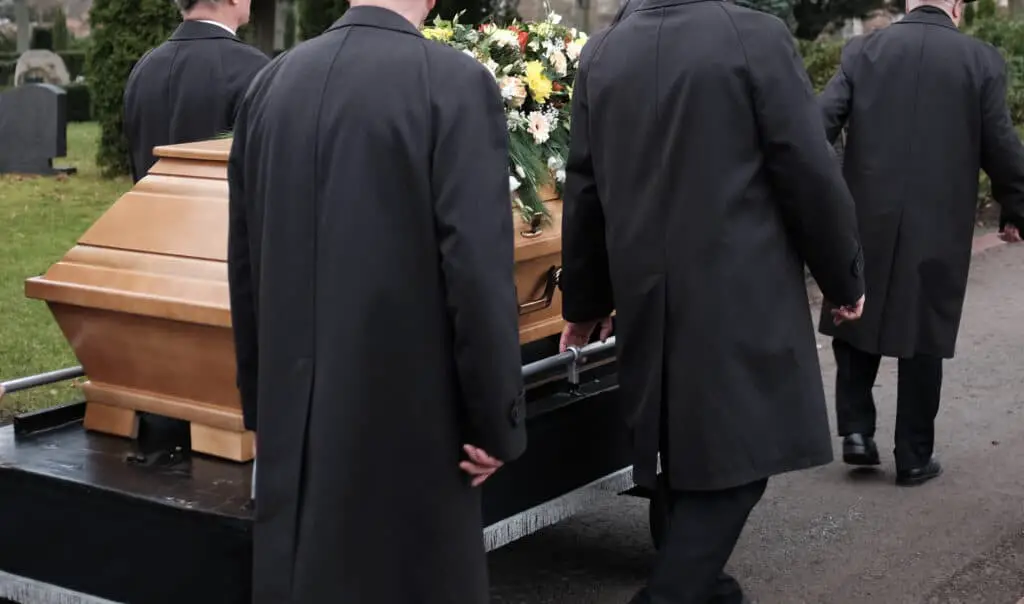One of the many parts of planning a funeral is choosing which of the departed’s loved ones will be included in the ceremony and their role, whether giving a eulogy or acting as a pallbearer. But how many pallbearers do you need?
Six to eight pallbearers is almost always the right number of people needed to carry a casket. Most caskets only have three handles on each side, or they have these handles plus handles in the front and back, allowing for six to eight pallbearers in total.
In the rest of this article, I’ll answer all the questions you may have about pallbearers, including how many handles caskets have, what pallbearers are and if they’re necessary, and how to pick pallbearers for a ceremony.
How Many Handles Do Caskets Have?
Most caskets have six handles. Some longer caskets have four on each side, so you’ll need eight. Similarly, some caskets have three handles on each side and then handles on the front and back. This means you’ll need from six to eight pallbearers to carry the casket.
Ultimately, the right number of pallbearers depends on the size and material of the casket, as well as the weight of the body. A larger body requires a larger casket, which may make it necessary to have more pallbearers carry it. Alternatively, if the departed was a child or just short and small, the casket will be lighter and narrower and won’t require as many pallbearers.
For more information, I recommend reading my article on how to pick the right casket size for your loved one.

How Heavy Are Caskets?
Another reason why you’ll need at least six pallbearers is that caskets are heavy. The weight of the casket will also impact how many pallbearers you’ll need. The following table outlines the average weight of common casket materials:
| Casket Material | Weight |
| Pine | 95-180 lb (43.09 – 81.64 kg) |
| Willow | 95-180 lb (43.09 – 81.64 kg) |
| Maple | 150-230 lb (68.03 – 104.32 kg) |
| Birch | 170-230 lb (77.11 – 104.32 kg) |
| Mahogany | 180-300 lb (81.64 – 136.07 kg) |
| Steel | 170-230 lb (77.11 – 104.32 kg) |
| Bronze | 250-300 lb (113.39 – 136.07 kg) |
| Copper | 260-320 lb (117.93 – 145.15 kg) |
| Wicker | 100-120 lb (45.35 – 54.43 kg) |
| Cardboard | 20-80 lb (9.07 – 36.28 kg) |
Keep in mind that this is the weight of the casket alone, and the body will only make it heavier. Therefore, a casket made of mahogany might require more pallbearers than a casket made of wicker.
On average, pallbearers must carry 350-400 lb (158.75 – 181.43 kg), including the casket with the body inside. This weight divided among six people is usually sufficient, especially if the pallbearers are mostly healthy adults. However, if the casket is oversized, made of mahogany, and the body inside is heavy, you may need to opt for eight pallbearers instead.
If you need help choosing a casket for your loved one, I have a guide on determining the right size, material, and more.
Sometimes, services have more pallbearers because some are honorary pallbearers. These people usually don’t physically carry the casket for whatever reason; they may be too sick, old, young, or just otherwise unable to take on the physical burden of the casket. However, if the departed or the family still wants to give that person the honor of being a pallbearer, they can walk alongside the casket with the rest of the pallbearers.
What Are Pallbearers?
In traditional funerals where the body is present, especially Christian and Jewish funerals, a group of six to eight people helps carry the casket containing the departed’s body. These people are known as the pallbearers of the funeral.
Historically, pallbearers had more influence over a funeral than they do today. In the 1950s and before, funeral homes hired pallbearers on an ad hoc basis to help make funeral arrangements and carry out logistics, such as providing a valet service, directing traffic on the day of the funeral, and carrying the casket.
In the Middle Ages, the pallbearers were men who held the pall, which is what they called the cloth that covered the casket. Hence, the name “pallbearers.”
Nowadays, pallbearers typically aren’t hired by the funeral home and are instead selected by the departed or their family to help carry the casket. These individuals are usually family and friends, and it is considered a great honor to be asked to perform this duty at a funeral.
The pallbearers carry the casket whenever it needs to be moved, including:
- From the funeral home and into the transportation.
- Down the aisle at the church or funeral home.
- From the church, or the location of the service, to the hearse.
- From the hearse to the gravesite.
Asking someone to be a pallbearer is a great way to highlight their closeness with the departed and give them an important role during the service that may help reduce their grief and make the experience less overwhelming.
Are Pallbearers Necessary?
Not every funeral requires pallbearers. The main example of a funeral that wouldn’t need people to fill this role is any kind of service or celebration of life in which the departed’s body isn’t present. If the body is never placed in a casket, pallbearers aren’t needed to carry the casket.
If your loved one didn’t identify who they would like to serve as a pallbearer, and you don’t feel comfortable making that decision, you can inform the funeral home and provide staff to carry the casket for you.
Additionally, if you have a few people you’d like to serve as pallbearers but don’t have six to eight people, the funeral home can assign extra employees to act as pallbearers and carry the weight of the casket. Alternatively, if your loved one was a member of a church, senior church leaders and young members of the church are often willing and able to help.
If you don’t want to use pallbearers at all, you don’t have to. In this case, the funeral home can choose another means of carrying the casket from place to place, usually a wheeled cart. Some funeral services have both the wheeled cart and pallbearers. In this case, the pallbearer role is more honorary and symbolic than functional, as they would walk alongside the casket instead of carrying it themselves.
Overall, it is entirely up to the departed and their loved ones whether or not they choose to include pallbearers in the service and under what circumstances they choose to do so.
How To Pick Pallbearers
Someone acting in the pallbearer role at a funeral can be a great honor, and it isn’t something to be taken lightly. If you are responsible for choosing pallbearers for a loved one’s funeral, or if you’re thinking about who you’d like to include in your funeral service, consider the following tips.
- If you’re choosing pallbearers, they should be people who were important to the departed in life. You can opt to have the funeral home assign staff to act as pallbearers, but if you’re picking these people, they should be individuals who had significant roles in the life of the departed. Often, pallbearers are friends, family members, neighbors, colleagues, or church members.
- Pallbearers should be physically fit enough to carry a casket. Caskets can be quite heavy, depending on the material of the casket itself and the heaviness of the body inside. Therefore, choosing people capable of carrying such a heavy burden is important. If you want to include someone unable to carry the casket in the service, they can serve as an honorary pallbearer and walk with the casket instead of carrying it themselves.
- Pallbearers need to be emotionally up to the task. Grief can be incredibly overwhelming and cause people to act in unexpected ways. Pallbearers have the task of carrying the casket, and they are often in front of the funeral attendees. Therefore, it is better to choose people who seem emotionally stable enough to do their job without breaking down in tears in the middle of the ceremony or becoming too grief-stricken to move.
- Choose people who will approach the role with dignity and honor. The departed may have been incredibly close with their young grandchild, but that doesn’t mean a child should act as a pallbearer. Pallbearers must be able to listen, take directions, arrive on time, stay calm during an emotional time, dress appropriately, and walk slowly.
- Don’t limit pallbearers to just men. Traditionally, adult men were the only people considered to be pallbearers. However, nowadays, people of all genders, ages, and abilities can participate, as long as the family deems them up to the task.
Picking pallbearers can seem overwhelming, but it is also a great way to highlight how beloved the departed was and comfort those grieving by offering them an honorary position in the service.
Conclusion
Having pallbearers carry the casket of a departed loved one is a great way to personalize the ceremony and honor the people the departed was close to in life. Usually, six to eight pallbearers are enough to carry the casket. Sometimes, people choose to have honorary pallbearers walk alongside the casket, which may result in more pallbearers.
